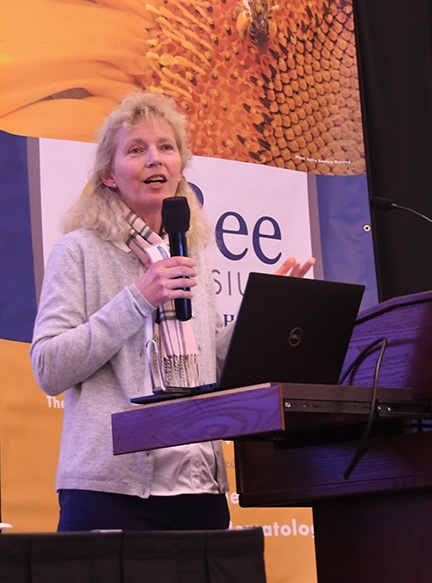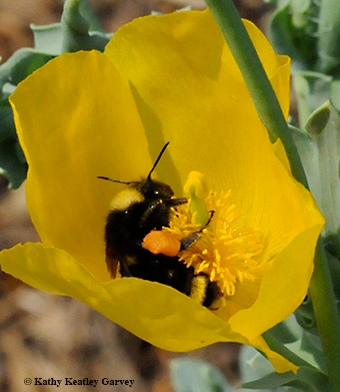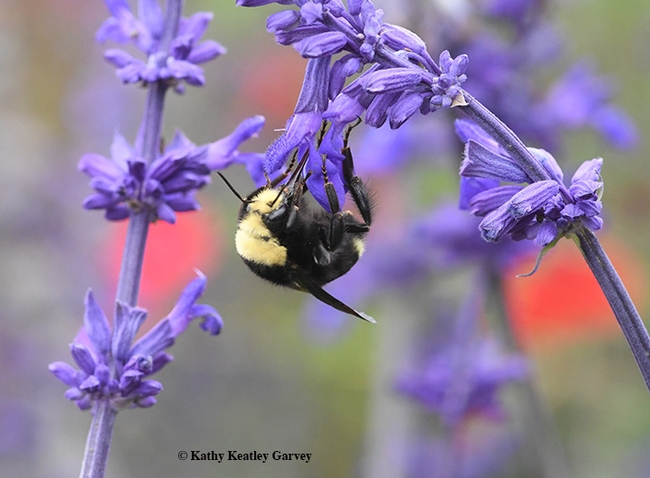
That's what world-class pollinator garden designer, pollinator advocate and author Kate Frey told the crowd at the fourth annual UC Davis Bee Symposium, hosted by the UC Davis Honey and Pollination Center and the UC Davis Department of Entomology and Nematology.
She's seen faces light up, steps quicken, and frowns turn to smiles as visitors tour gardens, including the ones she's designed at the Chelsea Flower Show in London, Sonoma Cornerstone in Sonoma, Lynmar Estate Winery and Gardens in Sebastopol, Melissa Gardens (privately owned) in Healdsburg, and the Ben and Kate Frey Gardens (privately owned) in Hopland.
“Bee gardens make us happy and are good for wildlife,” Frey reiterated. She's the co-author of the award-winning book, The Bee Friendly Garden, with Professor Gretchen LeBuhn of San Francisco State University, a book that details how to design an abundant, flower-filled garden that nurtures bees and supports biodiversity.
Frey, a two-time gold medal winner at the Chelsea Flower Show and co-founder of The American Garden School, illustrated her talk with photos of native bees, the plants they love, and the gardens they populate. In showing an image of a bumble bee on a California golden poppy, Frey commented “It looks like love.”
Yes, it does, the audience agreed.
Frey noted that of the 20,000 species of bees worldwide, 4000 species inhabit the United States, and 1600 of them are found in California. A good many of them, she said, are found in the UC Berkeley Urban Gardens launched by UC Berkeley Professor Gordon Frankie (see UC Berkeley Urban Bee Lab).
“Seventy-percent of our native bees are ground nesting,” she said, “so leave some uncovered space in your garden for them.”
“Our gardens can be positive spaces for diversity,” Frey related. "Native plants are best for native bees but many (bees) are generalists.” For example, the squash bee is a specialist, foraging only on cucurbits (these include squash, cucumber and zucchini), while bumble bees are generalists, foraging on scores of plants, from poppies to salvia (sage).

Frey offered these "simple rules for success" for bee gardeners:
- Create healthy gardens that require no pesticides by using the right plant, right approach, add quality compost to all plants and irrigate adequately
- Think in terms of abundance, not minimalism
- Aim for this goal: 12 months of bloom throughout the garden
- Plant annuals, perennials, shrubs and trees
- Make sure plants do offer floral resources, as many common landscape don't
- Provide patches or repeated plants of the same flower. Honey bees practice floral constancy
- Include water for honey bees
- Note that sunny spaces are the best.
- Use native and non-native plants.
- Provide mulch-free nest sites and drllled bee blocks (or "bee condos" where blue orchard bees and leafcutter bees can make their nests)
In the Frey gardens, "closeness" is important. "I have a phobia that plants SHOULD touch one another," she quipped. "Don't space them far apart."
Frey also pointed out that some so-called "weeds" shouldn't be labeled as such. "Some great weeds (that bees love) are Hemezonia congesta or tarweed and Trichostemma lanceolatum or vinegar weed," she said. Both are annual herbs that are native to California.
All in all, happiness is a bee garden.
As Frey writes in the introduction of The Bee Friendly Garden: "Spending time in a bee garden allows us to step into another world transcending the everyday routine and entering a place of beauty and anticipation. With these gardens, we develop and maintain a connection to something larger than ourselves--we get to see and know the intrinsic value of the flowers and the lives of the bees that visit them in each season."
Attached Images:
